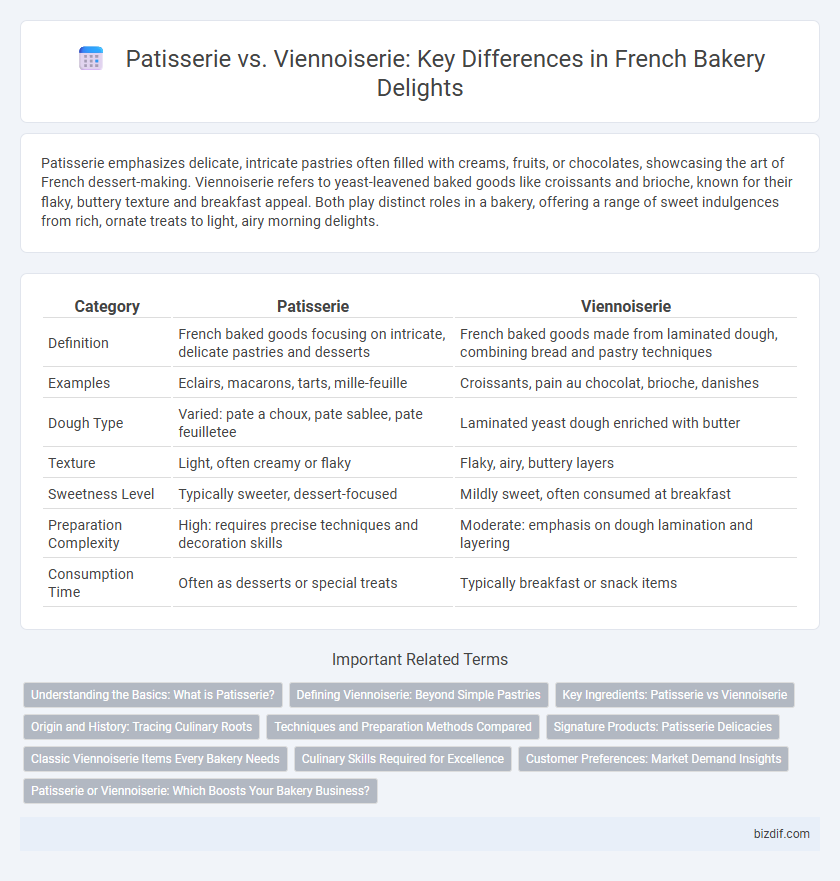Patisserie emphasizes delicate, intricate pastries often filled with creams, fruits, or chocolates, showcasing the art of French dessert-making. Viennoiserie refers to yeast-leavened baked goods like croissants and brioche, known for their flaky, buttery texture and breakfast appeal. Both play distinct roles in a bakery, offering a range of sweet indulgences from rich, ornate treats to light, airy morning delights.
Table of Comparison
| Category | Patisserie | Viennoiserie |
|---|---|---|
| Definition | French baked goods focusing on intricate, delicate pastries and desserts | French baked goods made from laminated dough, combining bread and pastry techniques |
| Examples | Eclairs, macarons, tarts, mille-feuille | Croissants, pain au chocolat, brioche, danishes |
| Dough Type | Varied: pate a choux, pate sablee, pate feuilletee | Laminated yeast dough enriched with butter |
| Texture | Light, often creamy or flaky | Flaky, airy, buttery layers |
| Sweetness Level | Typically sweeter, dessert-focused | Mildly sweet, often consumed at breakfast |
| Preparation Complexity | High: requires precise techniques and decoration skills | Moderate: emphasis on dough lamination and layering |
| Consumption Time | Often as desserts or special treats | Typically breakfast or snack items |
Understanding the Basics: What is Patisserie?
Patisserie refers to a French style of baking focused on intricate pastries and desserts such as eclairs, macarons, and tarts, characterized by delicate techniques and high-quality ingredients. It emphasizes sweet baked goods that often involve cream, custard, and refined doughs, showcasing artistry and precision. Unlike Viennoiserie, which includes yeast-leavened baked goods like croissants and brioche, patisserie centers around finer pastry work with detailed decoration and flavor complexity.
Defining Viennoiserie: Beyond Simple Pastries
Viennoiserie refers to a category of baked goods that combine elements of bread and pastry, characterized by rich, flaky, and buttery textures such as croissants, pain au chocolat, and brioche. Unlike traditional pastries that emphasize sweet fillings and delicate dough, viennoiseries are made from yeast-leavened dough enriched with butter, sugar, and eggs, creating a unique balance between fluffiness and flakiness. This hybrid nature distinguishes viennoiserie from patisserie, highlighting its role as a luxurious, everyday indulgence rather than purely decorative or sweet-centric treats.
Key Ingredients: Patisserie vs Viennoiserie
Patisserie primarily uses fine butter, sugar, eggs, and flour to create delicate pastries, emphasizing precision and artistry in desserts like eclairs and mille-feuilles. Viennoiserie incorporates yeast dough enriched with butter, milk, and eggs, resulting in flaky, airy baked goods such as croissants and brioche. The key difference lies in fermentation: patisserie dough is typically unleavened or chemically leavened, while viennoiserie relies on yeast for texture and rise.
Origin and History: Tracing Culinary Roots
Patisserie originates from French culinary tradition, specializing in delicate pastries such as eclairs and macarons that showcase intricate techniques rooted in 17th-century royal courts. Viennoiserie, though also French, derives its name from Vienna, Austria, reflecting the introduction of yeast-leavened baked goods like croissants and brioche in the 19th century through Austrian influence. Both categories highlight distinct historical evolutions in European baking, with patisserie emphasizing refined, sweet confections and viennoiserie focusing on buttery, laminated dough products with a rich cultural fusion.
Techniques and Preparation Methods Compared
Patisserie involves precise techniques such as lamination, creaming, and folding to create delicate pastries like eclairs and macarons, highlighting sugar work and intricate decoration. Viennoiserie focuses on yeast-leavened doughs enriched with butter and sugar, using lamination methods similar to croissants and brioche for a flaky, airy texture. Preparation in patisserie requires meticulous temperature control and timing for fine textures, while viennoiserie demands careful fermentation and proofing to develop volume and softness.
Signature Products: Patisserie Delicacies
Patisserie delicacies are characterized by intricate pastries such as eclairs, macarons, and mille-feuille, showcasing elaborate techniques and refined flavors that highlight French culinary artistry. These signature products emphasize delicate textures, precise layering, and often incorporate luxurious ingredients like almond paste, fresh cream, and fruit preserves. Unlike viennoiserie, which focuses on buttery, leavened doughs like croissants and brioche, patisserie prioritizes decorative finishes and complex compositions designed for sophisticated taste experiences.
Classic Viennoiserie Items Every Bakery Needs
Classic viennoiserie items every bakery needs include croissants, pain au chocolat, and brioche, known for their flaky, buttery layers that differentiate them from denser patisserie creations. These viennoiseries often use laminated dough, combining techniques from both bread making and pastry crafting to achieve a delicate texture and rich flavor. Offering a selection of viennoiserie products attracts customers seeking traditional French breakfast staples and elevates a bakery's product range beyond typical patisserie sweets.
Culinary Skills Required for Excellence
Patisserie demands precision in techniques such as tempering chocolate, sugar work, and delicate pastry layering, showcasing mastery in intricate decoration and flavor balance. Viennoiserie requires expertise in yeast fermentation, dough lamination, and careful timing to achieve light, flaky textures distinctive of croissants and brioche. Both disciplines necessitate advanced culinary skills but differ in their focus on pastry artistry versus bread-like richness and flakiness.
Customer Preferences: Market Demand Insights
Customer preferences in the bakery sector reveal a strong demand for both patisserie and viennoiserie items, driven by varying taste profiles and consumption occasions. Patisserie, known for its intricate designs and rich flavors, attracts consumers seeking indulgent desserts and special treats, while viennoiserie appeals to those favoring lighter, flaky pastries like croissants and brioches for breakfast or snacks. Market data indicates a growing trend toward artisanal and high-quality viennoiserie products, reflecting consumer interest in premium ingredients and traditional baking techniques.
Patisserie or Viennoiserie: Which Boosts Your Bakery Business?
Patisserie offers delicate, intricate pastries like eclairs and macarons that attract customers seeking elegance and variety, making it ideal for high-end bakery branding. Viennoiserie, including croissants and brioche, appeals to daily breakfast customers with its buttery, flaky texture, driving consistent sales and repeat business. Choosing between patisserie and viennoiserie depends on your target market--luxury clientele favors patisserie, while wider audiences benefit from the familiar comfort of viennoiserie.
Patisserie vs Viennoiserie Infographic

 bizdif.com
bizdif.com